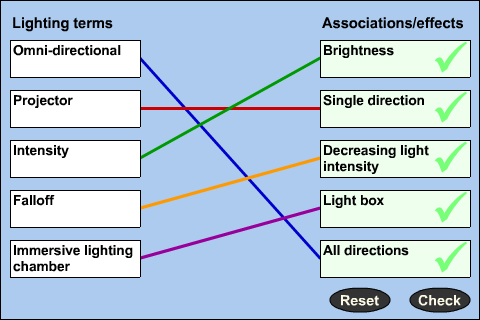

Lighting for architectural design in 3D virtual worlds

Immersive lighting chamber
Lighting considerations are fundamental in architectural design. It is important for designers to have the opportunity to explore the effect of different lighting techniques and online immersive 3D worlds can provide a useful environment for this purpose.
In these activities you will learn about experimentation with lighting in an online immersive 3D world, focusing on Second Life as an example. You will also consider the technical aspect of doing this whilst at the same time noting the kind of terminology used in this field in English. Prior knowledge of Second Life or other 3D immersive worlds is not necessary, but some experience with 3D modelling and basic understanding of lighting is recommended.
Activity 1: Lighting capabilities of 3D virtual environments
In this activity you are going to listen to the first part of a presentation about experimenting with lighting design in an online immersive 3D environment (Second Life).

Instruction
Watch the presentation and then complete this summary of key points that the speaker makes. You may need to listen to the recording several times and take some notes first in the text area provided. When you have completed the summary, compare your version with the one in the feedback. Then match each of the six lighting terms with its association or effect. Open the help section first if you would like to review some of the key terminology in English.
are environments where designers can experiment with lighting design in an interactive, collaborative manner, which typical 3D modelling systems cannot support. Virtual worlds are; thus, the objects to be rendered reside on a remote server.
Features that allow one to dynamically alter lighting parameters can also limit and complexity. A computer with fairly goodis required to support advanced lighting options. It's a good idea to check the software's website to find the required. For better performance, one can set a large number of options that adjust.
The differences between basic and advanced lighting affect the types of lights used and the rendering of a scene. Thus, the as well as the users within the virtual environment need to take into account their computer's graphics capabilities for lighting.
Here is a transcript of the first part of the presentation:
Part 1 transcript (pdf, 56KB). You may wish to print this document.
Activity 2: Technical aspects of using lighting in Second Life
In this activity you are going to watch the second part of the presentation which deals with technical aspects of using lighting in Second Life.

Instruction
Listen carefully to the second part of the presentation and decide if you think these statements are true or false. Select the appropriate button and then read the feedback. Listen once again to note any useful terminology. Then match each of the six lighting terms with its association or effect. Open the help section first if you would like to review some of the key terminology in English. When you have finished, read the feedback.
The light coming from a source within a prim can only be seen when the light strikes another object.
A beam of light cast from a light source can be accurately modelled.
The glow from a light bulb has to be roughly simulated.
The modelling of sunlight and moonlight are crude approximations of the actual phenomena.
The position of the sun can be set to accurately represent a location and time/date.
Here is a transcript of the second part of the presentation:
Part 2 transcript (pdf, 59KB). You may wish to print this document.
Here is a list of useful online resources in this area, which you may wish to refer to:
Second Life (Creating an account and downloading the Second Life viewer software)
Lighting and shadows (in Second Life)
Deferred Rendering Test (in Second Life)
Video tutorial (Second Life)
© Archi21 Project Consortium: Ecole Nationale Supérieure d'Architecture Paris-Malaquais, Open University, University of Ljubljana, Aalborg Universitet, University of Southampton and eLanguages, Modern Languages and Linguistics, University of Southampton, 2012.
This work is licensed under a Creative Commons Attribution-NonCommercial-NoDerivs CC BY-NC-ND Licence. 
 The light coming from a source within a prim can only be seen when the light strikes another object.
The light coming from a source within a prim can only be seen when the light strikes another object. A beam of light cast from a light source can be accurately modelled.
A beam of light cast from a light source can be accurately modelled.